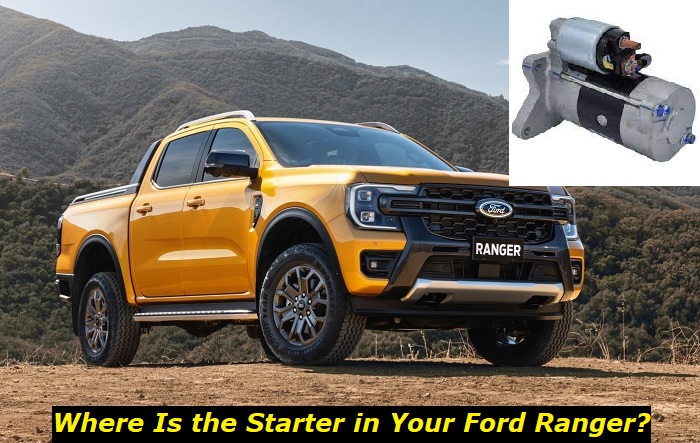The Ford Ranger is well regarded among gearheads for being one of the best mid-size pickup trucks on the market. The impressive performance and the rugged off-road characteristics offer a package unmatched by any other pickup truck in its segment.
Starter motor problems highlights
- Level of urgency:Medium
- Can you drive?Yes, if it starts
- DIY inspection:Possible but complicated
- DIY repair:Impossible
- Price for repair:$300 - $650
- Common Reasons:Internal problems, gear issues, flywheel problems, mount problems
- Ways to fix:Have it repaired by a professional

Where is the starter on a Ford Ranger?
As with all other vehicles, you have to look under the hood of the Ford Ranger to find its starter motor. There, you can find the starter motor at the base of the driver's side, next to the bell housing of the transmission.
You can easily distinguish the starter motor from the other engine components by its distinctive shape. The starter motor has two cylinders, one being larger than the other. One cylinder is the starter motor, and the other is the solenoid.
Still, having trouble finding the starter? Don't worry. We have another method you can try to locate it.
You can locate the starter by tracing the cable which connects to the battery's positive terminal. This cable is usually colored red and might have a plastic cover on top.
Once you identify the positive power cable, follow it through the engine bay until it connects to a connecting post attached to a large cylindrical object. And, ta-da! That cylindrical component is the starter.
But, be warned! Following the red cable inside the engine bay might get tricky at times. Remember to wear some protective gloves, and keep your eye out for any sharp objects.
Now that you know how to find the Ford Ranger's starter, let us shift our attention to some common indications of potential problems with it.
Symptoms of a bad starter
As with any mechanical problem, starter issues also have their own set of symptoms. Having a good understanding of these can make the difference between you getting stranded on the side of the road or making it home safely.
1) Smoke under the hood
No matter the situation, smoke inside the engine bay is never a good sign. Faulty starter motors are one of the main culprits for filling engine compartments with smoke.
Alongside the battery, the starter is another main electrical component of any vehicle. Issues with the starter may cause it to overheat, causing smoke buildup and a burning smell.
If your starter is smoking or smells like burnt plastic, do not try to start the vehicle. Instead, we recommend calling your nearest mechanic and having them take a look at it.
2) Weird sounds from the engine bay
A metallic ticking noise from the engine bay as soon as you turn the key is a tell-tale sign of a bad starter. In addition, grinding and humming sounds are also indicative of starter motor problems.
These noises usually happen when the internal components of the starter are worn out. Turning the key causes the starter to engage, rubbing and scratching these parts against each other.
If you hear weird sounds coming from the starter, it is important to get the issue sorted as soon as possible. Ignoring these noises can lead to some costly additional repairs, including flywheel damage.
3) Intermitted startup issues
If your Ranger has trouble starting up seemingly at random, it might be indicative of a starter issue. If the vehicle won't start on the first try but will do so on the second or third try, it might be time to have a mechanic take apart the starter motor.
4) Check engine light
Akin to other engine problems, starter motor issues can also cause the check engine light on the dashboard to turn on. Modern vehicles like the Ranger have advanced Engine Control Modules and will alert the driver through the warning light when it identifies a potential issue with the starter motor before things take a turn to the worst.
If you come across one or more of these symptoms, the starter motor of your Ford Ranger might be on its way out. So, are you wondering what the most common problems with the Ranger's starter motor are? If so, follow along.
Common Ford Ranger starter problems
There are several ways in which a starter motor can give up the ghost. Join us as we take a look at some of the most common ones.
1) The engine not turning when the starter engages
If the starter has a loose electrical connection, the engine won't turn no matter how many times it engages. Other causes of this problem include bad brushes, broken bearings, worn teething gear, and faulty internal windings within the starter.
There are several things you can try to remedy this issue. First, inspect all the electrical connections stemming from the starter motor. Check for corrosion in the cables, and ensure that everything is connected as it should.
If the wiring looks fine, you'll have to remove the starter from the Ranger to take a closer look at it. This is a job best left to the professionals.
2) Starter not turning off
Next, let's have a look at the other side of the spectrum. Sometimes, the starter motor may continue to run even after firing up the engine. As you might already guess, Ford never intended for this to happen.
Many causes may result in the starter refusing to turn off. Two of the common ones include electrical shorts and mechanical jams inside the part.
Continuing to drive your vehicle with a runaway starter is a bad idea. Not only would the starter smoke and overheat, but it would also significantly damage surrounding mechanical and electronic systems. Oh, and it would make a horrible noise too.
If the starter on your Ranger starts acting up in this manner, bring the truck to a stop as soon as possible. If turning off the ignition fails to stop the starter, you have no options left other than disconnecting the battery. Once it eventually stops, take it out and have a specialist inspect it.
3) The starter keeps turning without cranking the engine
If the starter keeps spinning without turning the engine, the issue lies with the pinion gears. These gears are responsible for engaging the ring gears on the flywheel, which cranks the engine and brings it to life. It requires the aid of the Bendix drive to make this process happen.
When the starter keeps grinding as you turn the key but nothing else happens, it's time to take a deeper dive under the hood. Thoroughly inspect whether the starter is correctly bolted to its mounting points. A single loose bolt is all it takes to mess up the starter's gearing mechanism.
If everything looks fine, you should take the starter out and have a look at the Bendix drive and teething gears. Rebuilding the worn-out parts or replacing the starter with a brand-new one will get rid of all your troubles.
How to make the starter last longer?
Replacing the starter motor in a Ford Ranger isn't a cheap fix. The cost of repairs can fall anywhere from $450 to $500 including parts and labor. Not interested in spending that much? Then, let us give you some tips on how to make the starter last much longer.
1) Prevent overheating
Overheating not only damages the engine internals but harms other accessories surrounding it as well. Ensuring that the cooling system is in proper working order is essential for prolonging the starter motor's service life.
2) Replace the battery on schedule
Ensuring that the battery is in proper working order also helps the starter motor last much longer. Ideally, you should replace the battery on your Ford Ranger every four to five years for maximum performance. Don't forget to inspect the battery regularly during routine maintenance.
3) Maintain the electrical system
If you want to make the starter last as long as possible, make sure that the electrical system is in good condition. Inspect the wiring for loose connections and corrosion, and replace damaged ones as soon as possible.
By following these tips, you can ensure that the starter motor of your Ford Ranger works reliably for years to come.
Final Thoughts
A working starter motor is essential for getting your Ford Ranger driving down the road, and now you know everything about it. Make sure to keep an eye out for the issues you discovered here, and follow our tips to extract the maximum service life out of the starter.
About the authors
The CarAraC research team is composed of seasoned auto mechanics and automotive industry professionals, including individuals with advanced degrees and certifications in their field. Our team members boast prestigious credentials, reflecting their extensive knowledge and skills. These qualifications include: IMI: Institute of the Motor Industry, ASE-Certified Master Automobile Technicians; Coventry University, Graduate of MA in Automotive Journalism; Politecnico di Torino, Italy, MS Automotive Engineering; Ss. Cyril and Methodius University in Skopje, Mechanical University in Skopje; TOC Automotive College; DHA Suffa University, Department of Mechanical Engineering






Add comment